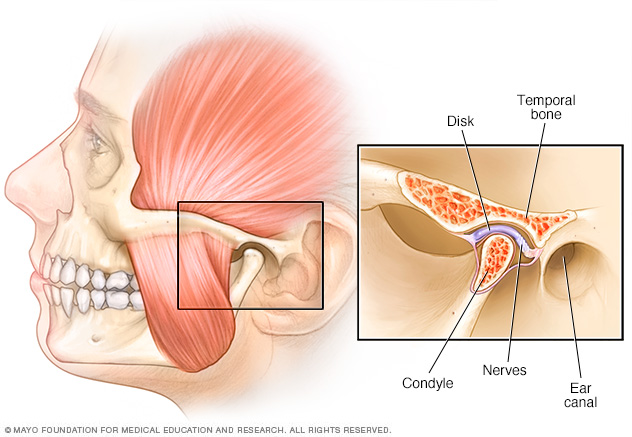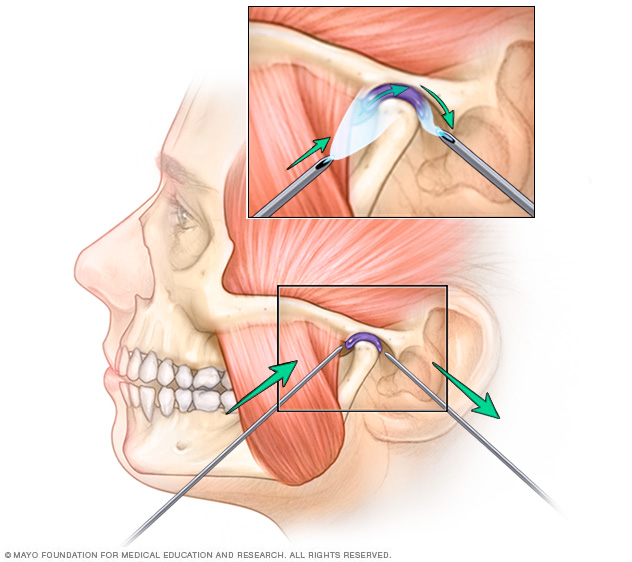Overview
The temporomandibular (tem-puh-roe-man-DIB-u-lur) joint, also called TMJ, acts like a sliding hinge. It connects the jawbone to the skull. There is one joint on each side of the jaw. TMJ disorders — a type of temporomandibular disorder or TMD — can cause pain in the jaw joint and in the muscles that control jaw movement.
The exact cause of TMJ disorder is often hard to determine. The pain may be due to a mix of factors, including habits such as teeth clenching, gum chewing and nail biting; stress; and painful conditions that occur along with TMJ disorder such as fibromyalgia, osteoarthritis or jaw injury. The habit of teeth clenching or grinding also is known as bruxism.
Most of the time, the pain and discomfort related to TMJ disorders lasts for only a limited time. Self-managed home care, physical therapy for the jaw and the use of a mouth guard can be effective in treating symptoms of TMJ disorder. Surgery is usually a last resort after conservative measures have failed. But surgical treatments may help some people with TMJ disorders.

Symptoms
Symptoms of TMJ disorders may include:
- Pain or tenderness in the jaw.
- Pain in one or both temporomandibular joints.
- Aching pain in and around the ear.
- Having a hard time chewing or pain while chewing.
- Aching facial pain.
- Locking of the joint, making it hard to open or close your mouth.
- Headache.
- Neck pain.
- Eye pain.
- Tooth pain that occurs along with jaw tenderness.
TMJ disorders also can cause a clicking sound or grating sensation when you open your mouth or chew. But if there's no pain or limitation of movement related to your jaw clicking, it's likely that you won't need treatment.
When to see a doctor
Seek medical attention if you have constant pain or tenderness in your jaw that occurs suddenly or during jaw movements or if you can't open or close your jaw completely. Your dentist, TMJ specialist or other healthcare professional can discuss possible causes and treatments.
Causes
The temporomandibular joint combines a hinge action with sliding motions. The parts of the bones that work together in the joint are covered with cartilage and separated by a small shock-absorbing disk. This disk usually keeps the movement smooth.
Painful TMJ disorders can happen if:
- The disk erodes or moves out of its proper relationship between the ball and socket of the joint.
- Sprain or strain occurs in the ligaments or soft tissues associated with TMJ disorders.
- Arthritis damages the joint's cartilage.
- A blow or another impact damages the joint.
- Jaw muscles are associated with TMJ spasms.
Many times, the cause of TMJ disorder has a variety of causes and is hard to identify.
Risk factors
Factors that may raise the risk of getting TMJ disorders include:
- Different types of arthritis, such as rheumatoid arthritis or osteoarthritis.
- Jaw injury.
- Habits such as gum chewing, nail biting, and grinding or clenching of teeth.
- Certain connective tissue diseases.
- Stress, post-traumatic stress disorder, anxiety or depression.
- Conditions such as fibromyalgia, ankylosing spondylitis and sleep disturbances.
- Smoking.
Diagnosis
Your healthcare professional will likely discuss your symptoms and study your jaw by:
- Listening to and feeling your jaw when you open and close your mouth.
- Watching the range of motion in your jaw.
- Pressing on areas around your jaw to find sites of pain or discomfort.
If your healthcare professional thinks there is an issue, you may need:
- Dental X-rays to look at your teeth and jaw.
- CT scan to show detailed images of the bones involved in the joint.
- MRI to show issues with the joint's disk or surrounding soft tissue.
TMJ arthroscopy is sometimes used to diagnose a TMJ disorder. During TMJ arthroscopy, your healthcare professional inserts a small thin tube called a cannula into the joint space. Then a small camera called an arthroscope is inserted to look at the area and help find a diagnosis.
TMJ arthroscopy also is sometimes used to treat TMJ disorder. The procedure can help with therapy, such as releasing scar tissue and removing inflammatory soft tissue and byproducts to improve TMJ symptoms and help the jaw move without pain.
Treatment
Sometimes the symptoms of TMJ disorders may go away without treatment. If your symptoms don't go away, your healthcare professional may recommend treatment options, often more than one to be done at the same time.
Medications
Along with other treatments that don't involve surgery, these medicine options may ease the pain related to TMJ disorders:
- Pain relievers and anti-inflammatories. If pain medicines available without a prescription aren't enough to relieve TMJ pain, your healthcare professional may prescribe stronger pain relievers for a limited time, such as prescription-strength ibuprofen (Advil, Motrin IB, others).
- Tricyclic antidepressants. These medicines, such as nortriptyline (Pamelor), are used mostly for depression. But in low doses, they're sometimes used to ease pain, control bruxism and help with sleeplessness.
- Muscle relaxants. These medicines are sometimes used for a few days or weeks to ease pain caused by TMJ disorders that muscle spasms create.
Therapies
Therapies for TMJ disorders that don't involve drugs include:
- Self-care. To ease symptoms, apply heat or ice, depending on the type of TMJ symptoms. Avoid teeth clenching, gum chewing and nail biting. Practice good resting jaw posture with the tongue gently rested on the palate, teeth apart and jaw in a relaxed position.
- Oral splints or mouth guards. Often, people with jaw pain will benefit from wearing a soft or firm device inserted over their teeth. The reasons why these devices help are not well understood.
- Physical therapy. Along with exercises to stretch and strengthen jaw muscles, treatments might include ultrasound and transcutaneous electrical nerve stimulation, also known as TENS. Also, moist heat and stretching are effective in repeated applications throughout the day.
- Counseling. Education and counseling can help you learn more about the factors and behaviors that may worsen your pain, so you can change your behavior. Examples include teeth clenching or grinding, leaning on your chin, or biting fingernails.
Surgical or other procedures
When other methods don't help, your healthcare professional might suggest procedures such as:
- Arthrocentesis. Arthrocentesis (ahr-throe-sen-TEE-sis) is a minimally invasive procedure that involves inserting small needles into the joint so that fluid can flow through the joint to remove debris and inflammatory byproducts.
- Injections. In some people, corticosteroid injections into the joint may help. Rarely, injecting botulinum toxin type A (Botox, others) into the jaw muscles used for chewing may ease pain related to TMJ disorders.
- TMJ arthroscopy. Sometimes arthroscopic surgery can be as effective for treating various types of TMJ disorders as open-joint surgery. A small thin tube called a cannula is placed into the joint space. Then an arthroscope is inserted, and small surgical instruments are used for surgery. TMJ arthroscopy has fewer risks and complications than open-joint surgery does. But it has some limitations too.
- Modified condylotomy. Modified condylotomy (kon-dih-LOT-uh-mee) addresses the TMJ indirectly, with surgery on the mandible but not in the joint itself. It may ease pain and locking.
- Open-joint surgery. If your jaw pain does not go away with more-conservative treatments and a structural issue in the joint appears to be causing the pain, your healthcare professional may suggest open-joint surgery to repair or replace the joint. But open-joint surgery involves more risks than other procedures do. Think about this procedure very carefully after discussing the pros and cons with your healthcare professional.
If your healthcare professional recommends surgery or other procedures, be sure to talk about the possible benefits and risks. Also, ask about all your options.

Lifestyle and home remedies
Become more aware of habits linked with stress — clenching your jaw, grinding your teeth or chewing pencils — so you won't do them as often. These tips may help you reduce symptoms of TMJ disorders:
- Avoid overuse of jaw muscles. Eat soft foods. Cut food into small pieces. Steer clear of sticky or chewy food. Don't chew gum.
- Practice gentle stretching and massage. A physical therapist or other healthcare professional can show you how to do exercises that stretch and strengthen your jaw muscles and how to massage the muscles yourself.
- Apply heat or cold. Applying warm, moist heat or an ice pack to the side of your face may ease pain. Acute pain is best treated with an ice pack. Chronic dull pain is best treated with heat therapy. Apply heat or cold for 15 to 20 minutes several times a day. This approach, combined with stretching, has been found to be very effective.
- Adjust your diet. Eating soft foods or smaller pieces of food, not opening your mouth too wide, and eating foods using utensils such as a spoon or fork may ease symptoms. Chewing foods with both sides of the mouth and not just one side also may ease symptoms.
Alternative medicine
Complementary and alternative medicine techniques may help manage ongoing pain often related to TMJ disorders. Examples include:
- Acupuncture. A specialist trained in acupuncture treats ongoing pain by inserting hair-thin needles at specific locations on your body.
- Relaxation techniques. Consciously slowing your breathing and taking deep, regular breaths can relax tense muscles. In turn, this can lessen pain.
- Biofeedback. Electronic devices that track the tightness of specific muscles can help you practice effective relaxation techniques.
Preparing for an appointment
You'll probably first talk about your TMJ symptoms with your family healthcare professional or dentist. If suggested treatments don't give you enough relief, you may be referred to a healthcare professional who specializes in TMJ disorders.
What you can do
You may want to prepare a list that answers these questions:
- When did your symptoms begin?
- Have you ever had this occur in the past?
- Has your level of stress increased recently?
- Do you have headaches, neck aches or toothaches that occur often?
- What medicines and supplements do you take regularly?
What to expect from your doctor or dentist
Your healthcare professional may ask some of these questions:
- Is your pain constant or do your symptoms come and go?
- Does any activity seem to cause pain?
- Does your jaw click or pop when you move it? Is that clicking painful?
- Is it hard to open your mouth in the usual way?
Your healthcare professional will ask more questions based on your responses, symptoms and needs. Preparing and expecting questions will help you make the most of your time.
© 1998-2025 Mayo Foundation for Medical Education and Research (MFMER). All rights reserved. Terms of Use


